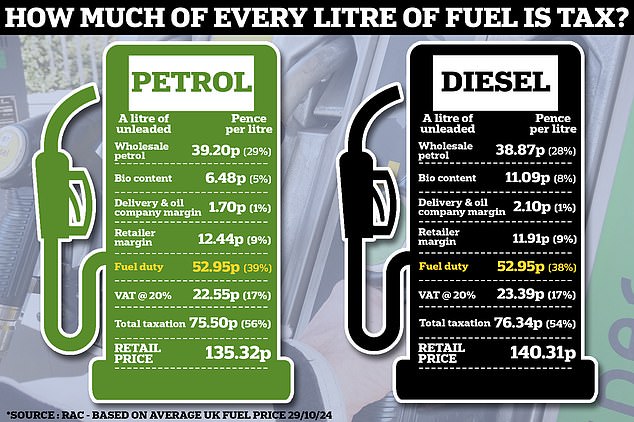Gasoline and diesel prices remain at three-year lows as Reeves freezes taxes
- The average petrol price stands at 135.2 cents after the Chancellor confirmed the fuel rate freeze
Fuel prices remain at their lowest level in three years, according to the latest data from the RAC.
The average price of petrol at the pump now stands at 135.2 cents, after the Chancellor confirmed in the Budget that fuel duty would remain frozen for a further 12 months.
It also comes despite a brief rise in oil prices in October as tensions continue to rise in the Middle East.
The average price of petrol at the pump now stands at 135.2 cents after the Chancellor confirmed in the Budget that fuel duty would remain frozen for a further 12 months
At 135.2pa liters of petrol this is currently a third of a pence in September, the RAC Fuel Watch shows, meaning the cost of filling up a 55-litre family car is £74.40.
Diesel rose by two-thirds of a pence to 140.2p, taking the cost of refueling a family car to just over £77.
Diesel in Britain is the most expensive in Europe and has been the case for the past 21 out of 27 weeks.
There are ways to keep the cost of filling a tank down, including going to a supermarket: the average price of unleaded purchased at one of the 1,487 gas stations across the country is 132 cents and diesel is 136.8 cents .
Currently, filling up at a supermarket can save drivers 3p per litre, or almost £2 per tank.
And being a member of Costco’s, a membership-only retailer, also pays off at the pump: 20 Costco stores in England and Scotland sell petrol for 127 pence per liter and diesel for 131.7 pence – more than 8 pence less than the UK averages .
One part of Britain benefiting from even lower pump prices is Northern Ireland.
Petrol currently costs an average of 130.4p and diesel 134.1p – 5p and 6p less than the UK averages for both fuels, and 2p cheaper than the average supermarket price.
In addition to freezing fuel duty for the 15th consecutive year, the budget revealed that the government will start monitoring fuel prices in two months.
Simon Williams, RAC’s head of policy, said: ‘With prices in Northern Ireland still at least 5p per liter cheaper than the UK average, it was also positive to see at the Budget that the Government is committed to improving Competition and Markets Authority to use its statutory powers to monitor competition in the road fuels retail market in just two months.
‘The Government has also recognised, as the RAC has been advocating for some time, that ‘this function will be critical in providing ongoing monitoring of prices and in considering whether further action may be necessary to protect consumers.’
The government’s ‘Fuel Finder’ scheme will come into effect at the end of 2025, meaning every retailer will have to report their prices to a central database within 30 minutes of a change being made.
During last week’s Budget, the Chancellor said increasing fuel duty “while the cost of living remains high, and against a backdrop of global uncertainty” would have been the “wrong choice for working people”.
Motoring groups welcomed the Chancellor’s announcement, with the RAC saying drivers will ‘breathe a huge sigh of relief’ and AA president Edmund King declaring: ‘On the eve of the Halloween Budget, the Chancellor has come up with a treat for drivers.’
What does the freezing of the 5 cent discount mean for drivers?

Fuel taxes – and VAT – already make up more than half of what drivers pay at the pump. Currently, 56% of every liter of petrol is taxable – and 54% for diesel
If Rachel Reeves had scrapped the 5p discount with immediate effect, the cost of a liter of petrol and diesel would have risen by 6p, with a further penny added to the bill due to higher VAT on road fuels.
On Budget day, the average unleaded price was 135.3 cents. Therefore, it would theoretically have risen to 141.32p, while diesel would have risen from 140.3p to 146.3p.
This would have meant that an average family car with a 55 liter fuel tank would have cost an extra £3.30 to fill up.
Over the course of a year, based on an average mileage of 7,000 miles per year, drivers could expect to have spent an additional £48 on fuel vouchers over the course of a year.
How does the price of crude oil change the price of gasoline?
The industry standard is that 1 pence per liter must be topped up at the pump for every $2 per barrel change in the price of crude oil, meaning that a $20 increase will lead to a £5.50 increase in the cost of filling a typical 55-gallon fuel tank.
And retailer margins are adding more than 6 cents per liter to gasoline costs.
